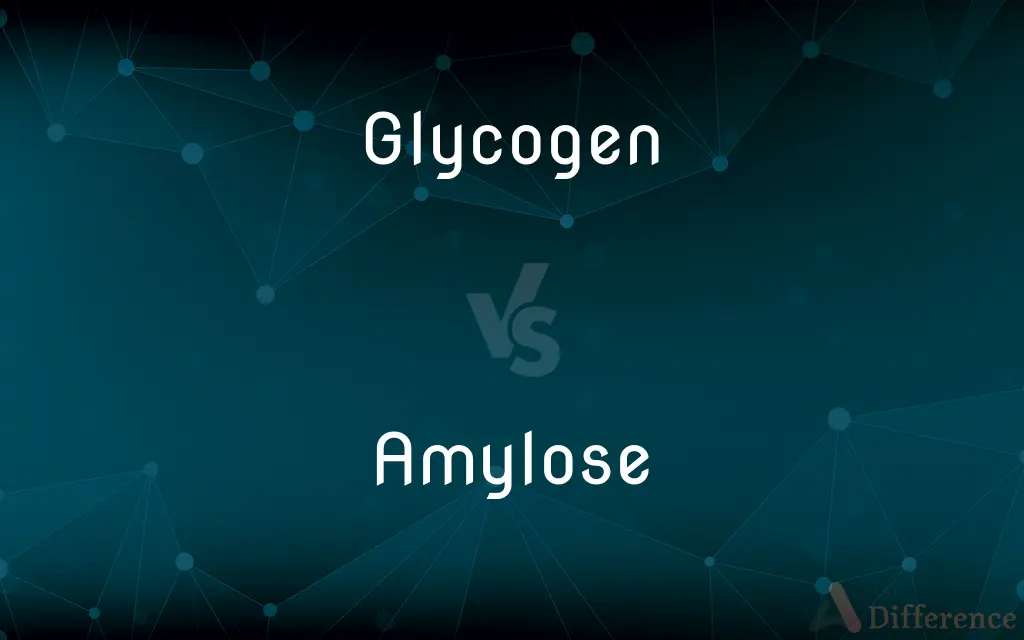Glycogen vs. Amylose — What's the Difference?
Edited by Tayyaba Rehman — By Fiza Rafique — Updated on November 6, 2023
Glycogen is a branched polymer of glucose storing energy in animals; amylose is a linear polymer of glucose in plants.

Difference Between Glycogen and Amylose
Table of Contents
ADVERTISEMENT
Key Differences
Glycogen is the primary form of energy storage in animals, fungi, and bacteria, functioning similarly to starch in plants. It is a highly branched molecule, allowing for rapid release of glucose when energy is needed. Amylose, on the other hand, is a component of starch and serves as an energy reserve in plants. It is mostly linear with a few branches, which makes it less readily accessible for quick energy release compared to glycogen.
The structure of glycogen with its extensive branching allows for quick access and breakdown by enzymes, leading to fast energy release during metabolic processes. Amylose’s structure, being more linear, is digested more slowly, providing a gradual release of energy. This structural difference affects how energy is stored and released in organisms that rely on glycogen versus those that store amylose.
In terms of solubility, glycogen is generally less soluble in water than amylose due to its larger size and extensive branching. However, both are insoluble in alcohol. Amylose tends to form a colloidal suspension in hot water, which can be identified with an iodine test that turns it blue, indicating the presence of starch.
Glycogen’s synthesis and degradation are regulated by hormones such as insulin and glucagon, which respond to the energy needs of an animal’s body. Amylose synthesis, part of starch synthesis in plants, occurs in plastids (like chloroplasts) and is not regulated by hormones but rather by the plant's metabolic needs and available resources.
Lastly, glycogen has a compact structure due to its branches, which allows it to be densely packed in cells. Amylose contributes to the semi-crystalline structure of starch granules in plants. The packing of glucose units in amylose is not as dense due to its more linear chains, affecting how it is stored in plant cells.
ADVERTISEMENT
Comparison Chart
Primary Function
Energy storage in animals
Energy storage component in plants
Structure
Highly branched
Mostly linear
Solubility
Less soluble in water
More soluble in hot water
Digestion
Rapidly digested for quick energy
Digested slowly for gradual energy
Regulation
Hormonally regulated
Not hormonally regulated
Compare with Definitions
Glycogen
The main form of carbohydrate storage in animals.
Athletes often have higher glycogen stores due to their training.
Amylose
The simpler form of starch, consisting mostly of unbranched chains.
Amylose content in rice determines whether it is sticky or fluffy after cooking.
Glycogen
An animal starch with a complex, branched structure.
Glycogen breakdown provides glucose when blood sugar levels drop.
Amylose
One of the two components of starch, the other being amylopectin.
Waxy potatoes have less amylose and are therefore more suited to boiling.
Glycogen
A glucose reserve that can be rapidly mobilized.
During exercise, muscle cells break down glycogen to sustain energy levels.
Amylose
A polysaccharide that forms a colloidal suspension in hot water.
Amylose and amylopectin together contribute to the starch's ability to thicken sauces.
Glycogen
A branched glucose polymer stored in animal tissues.
After a meal, excess glucose is stored in the liver as glycogen.
Amylose
A linear polysaccharide found in plants as part of starch.
Amylose is responsible for the firm texture of unripe bananas.
Glycogen
A polysaccharide that serves as a form of energy storage in fungi and bacteria, as well as animals.
Glycogen levels in the liver fluctuate between meals and fasting states.
Amylose
A carbohydrate molecule that can be stained blue with iodine.
The presence of amylose in a plant cell can be visualized using an iodine test.
Glycogen
Glycogen is a multibranched polysaccharide of glucose that serves as a form of energy storage in animals, fungi, and bacteria. The polysaccharide structure represents the main storage form of glucose in the body.
Amylose
Amylose is a polysaccharide made of α-D-glucose units, bonded to each other through α(1→4) glycosidic bonds. It is one of the two components of starch, making up approximately 20-30%.
Glycogen
A polysaccharide, (C6H10O5)n, that is the main form of carbohydrate storage in animals and is found primarily in the liver and muscle tissue. It is readily converted to glucose as needed by the body to satisfy its energy needs. Also called animal starch.
Amylose
A linear, unbranched polysaccharide that is one of the two main components, along with amylopectin, of starches.
Glycogen
(carbohydrate) A polysaccharide that is the main form of carbohydrate storage in animals; converted to glucose as needed.
Amylose
(carbohydrate) The soluble form of starch (the insoluble form being amylopectin) that is a linear polymer of glucose.
Glycogen
A white, amorphous, tasteless substance resembling starch, soluble in water to an opalescent fluid. It is found abundantly in the liver of most animals, and in small quantity in other organs and tissues, particularly in the embryo. It is quickly changed into sugar when boiled with dilute sulphuric or hydrochloric acid, and also by the action of amylolytic ferments.
Amylose
One of the starch group (C6H10O5)n of the carbohydrates; as, starch, arabin, dextrin, cellulose, etc.
Glycogen
One form in which body fuel is stored; stored primarily in the liver and broken down into glucose when needed by the body
Common Curiosities
What foods are high in amylose?
Foods such as legumes, whole grains, and certain varieties of rice and potatoes are high in amylose.
How does glycogen support energy needs?
Glycogen can be quickly broken down to glucose to meet immediate energy demands.
What is glycogen?
Glycogen is a branched glucose polymer that acts as energy storage in animals.
Are glycogen and amylose found together in any food sources?
No, glycogen is found in animal products, while amylose is found in plants.
Do plants store glycogen?
No, plants store energy in the form of starch, which includes amylose and amylopectin, not glycogen.
What is the impact of amylose on blood sugar levels?
Amylose has a slower impact on blood sugar levels compared to simple sugars.
What is amylose?
Amylose is a polysaccharide, part of plant starch, with a predominantly linear structure.
Is amylose or glycogen more complex structurally?
Glycogen is more complex due to its extensive branching.
Where is glycogen stored?
Glycogen is stored mainly in the liver and muscle cells of animals.
How are glycogen and amylose similar?
Both are glucose polymers used for energy storage.
How does the body use glycogen during exercise?
During exercise, the body breaks down glycogen into glucose for muscle energy.
Can humans digest amylose?
Yes, humans have enzymes to digest amylose, although it is digested more slowly than glycogen.
How does the structure of glycogen benefit animals?
The structure of glycogen allows for rapid release of glucose when needed.
What role does amylose play in the diet?
Amylose is digested slowly, contributing to sustained energy and feeling full longer.
Can glycogen and amylose be digested without enzymes?
No, specific enzymes are needed to break down both glycogen and amylose into glucose.
Share Your Discovery

Previous Comparison
Undertaking vs. Enterprise
Next Comparison
Muddled vs. ConfusedAuthor Spotlight
Written by
Fiza RafiqueFiza Rafique is a skilled content writer at AskDifference.com, where she meticulously refines and enhances written pieces. Drawing from her vast editorial expertise, Fiza ensures clarity, accuracy, and precision in every article. Passionate about language, she continually seeks to elevate the quality of content for readers worldwide.
Edited by
Tayyaba RehmanTayyaba Rehman is a distinguished writer, currently serving as a primary contributor to askdifference.com. As a researcher in semantics and etymology, Tayyaba's passion for the complexity of languages and their distinctions has found a perfect home on the platform. Tayyaba delves into the intricacies of language, distinguishing between commonly confused words and phrases, thereby providing clarity for readers worldwide.















































